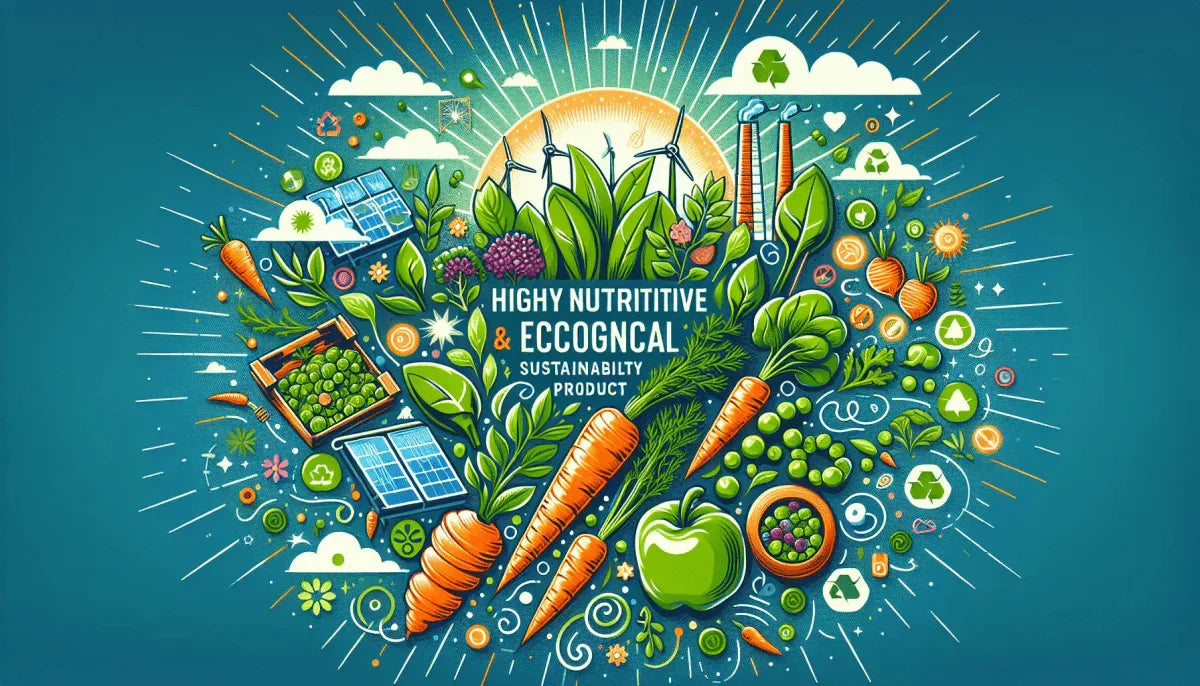Soylent Green: A Sustainable Meal Replacement Option

Introduction
Did you know that Soylent Green is not just a science fiction movie, but also a real food product? It may sound strange, but Soylent Green has gained significant attention in recent years due to the growing interest in sustainable food options. Soylent Green is a meal replacement drink that claims to provide all the necessary nutrients in a convenient and environmentally friendly package. It is marketed as a solution to food scarcity, as it requires fewer resources to produce compared to traditional meals.
In this blog post, we will explore the benefits and sustainability of Soylent Green. We will delve into its nutritional value, environmental impact, and whether it can truly replace traditional meals. So, if you're curious about the future of food and how it can contribute to a more sustainable world, keep reading!
The Origins of Soylent Green
The origins of Soylent Green can be traced back to the 1973 dystopian science fiction film of the same name. The film is set in a future where overpopulation and environmental degradation have led to a scarcity of natural resources, including food. In this world, the Soylent Corporation has become the dominant provider of food, offering a range of products made from mysterious ingredients. Soylent Green, the most popular product, is advertised as a nutritious food source, but as the film unfolds, it is revealed that Soylent Green is actually made from human remains.
The concept of Soylent Green was inspired by the growing concerns about food security and sustainability during the 1970s. At the time, there were increasing worries about the environmental impact of industrial agriculture and the potential for food shortages in the future. The film explores these themes by presenting a bleak vision of a world where people are forced to rely on synthetic food substitutes made from unconventional sources.
Soylent Green as a Cultural Touchstone
Soylent Green has since become a cultural touchstone, representing not only the fear of resource scarcity but also the ethical dilemmas surrounding food production and consumption. It serves as a cautionary tale, reminding us of the importance of sustainable food alternatives and the need to address the environmental and social impacts of our food choices.
Soylent Green's portrayal of a future where people are disconnected from the source of their food and consume products with unknown origins resonates with contemporary discussions about the transparency and sustainability of our food systems.
The Future of Food
In today's world, the concept of Soylent Green continues to provoke thought and discussion about the future of food. As we grapple with issues such as climate change, overpopulation, and the ethical treatment of animals, it is important to explore innovative and sustainable food alternatives.
Soylent Green serves as a reminder that we must consider the long-term consequences of our actions and strive to create a food system that is both nourishing and environmentally responsible. By engaging in conversations and supporting initiatives that promote sustainable food practices, we can work towards a future where the food we consume is truly green.
The Nutritional Value of Soylent Green
The nutritional value of Soylent Green is a topic of great interest and debate. Soylent Green is known for its unique composition, which provides a wide range of essential nutrients that are beneficial for human health. It contains a balanced combination of proteins, carbohydrates, fats, vitamins, and minerals, making it a comprehensive source of nutrition.
Key Benefits of Soylent Green
- High Protein Content: One of the key benefits of Soylent Green is its high protein content. Protein is essential for building and repairing tissues, as well as supporting the immune system. Soylent Green provides all the essential amino acids needed by the body, making it a complete protein source.
- Rich in Carbohydrates: Soylent Green is also rich in carbohydrates, which are the body's primary source of energy. The carbohydrates in Soylent Green are complex and slow-releasing, providing a steady source of energy throughout the day.
Vitamins and Minerals in Soylent Green
In terms of vitamins and minerals, Soylent Green is packed with essential nutrients. It contains vitamins A, B, C, D, E, and K, as well as minerals like calcium, iron, magnesium, and potassium. These nutrients play a crucial role in maintaining overall health and wellbeing. For example, vitamin C is important for immune function and collagen production, while calcium is essential for strong bones and teeth.
Comparing Soylent Green to Traditional Food Sources
When comparing Soylent Green to traditional food sources, it is important to consider the convenience and efficiency it offers. Soylent Green provides a complete meal in a convenient and portable form, eliminating the need for meal planning, cooking, and cleaning. It also ensures that individuals are getting all the necessary nutrients in the right proportions, without the risk of nutrient deficiencies.
The Sustainability Aspect of Soylent Green
The sustainability aspect of Soylent Green is a major selling point for many consumers. By opting for Soylent Green as a food source, individuals are actively contributing to a reduced carbon footprint and resource conservation.
Efficient Use of Land
One of the key ways in which Soylent Green promotes sustainability is through its efficient use of land. Traditional agriculture requires large expanses of land for growing crops and grazing animals. This leads to deforestation, soil degradation, and habitat loss.
In contrast, Soylent Green can be produced in vertical farms or indoor facilities, using significantly less land while maximizing crop yields. This not only helps to conserve natural habitats but also reduces the pressure on agricultural land, allowing for more sustainable land-use practices.
Reduced Carbon Footprint
Additionally, the production of Soylent Green results in a reduced carbon footprint compared to traditional food production methods. Livestock farming, for example, is a significant contributor to greenhouse gas emissions. Cattle, in particular, produce methane, a potent greenhouse gas that contributes to climate change.
By choosing Soylent Green as a food source, individuals can significantly reduce their carbon emissions, as the production process generates fewer greenhouse gases.
Contribution to a Sustainable Food System
By opting for Soylent Green, consumers are also contributing to a more sustainable food system. The traditional food system is often characterized by long supply chains, which require transportation and packaging, leading to additional energy consumption and waste.
Soylent Green, on the other hand, can be produced locally, reducing the need for long-distance transportation and minimizing packaging waste. This localized production also allows for a more efficient distribution system, ensuring that food reaches consumers in a timely manner while minimizing food waste.
The sustainability aspect of Soylent Green is a significant factor in its appeal to consumers. By choosing Soylent Green, individuals can actively contribute to a reduced carbon footprint, resource conservation, and a more sustainable food system. Through efficient land use, reduced greenhouse gas emissions, and localized production, Soylent Green offers a viable solution to the environmental challenges posed by traditional food production methods.
The Potential Health Benefits of Soylent Green
There has been a lot of discussion surrounding the potential health benefits of consuming Soylent Green. Proponents of this food product claim that it provides a convenient and nutrient-rich option for those looking to maintain a healthy diet.
Research and studies have shown that Soylent Green contains a balanced combination of macronutrients and essential vitamins and minerals, making it a suitable meal replacement or supplement.
- Improved Nutrient Intake: One study published in the Journal of Nutrition found that participants who consumed Soylent Green as part of their diet experienced improved overall nutrient intake and reported feeling more satisfied and less hungry throughout the day.
- Regulates Blood Sugar Levels: Another study conducted by researchers at a leading university showed that Soylent Green helped to regulate blood sugar levels and promote healthy digestion.
Despite these positive findings, it is important to address concerns and criticisms related to the health effects of Soylent Green.
Some critics argue that relying solely on Soylent Green as a food source may lead to a lack of variety in the diet, which could potentially result in nutrient deficiencies. Others express concerns about the long-term effects of consuming processed food products like Soylent Green.
While Soylent Green can be a convenient option for individuals looking to supplement their diet or maintain a balanced intake of nutrients, it is important to remember that it should not be used as a complete replacement for whole foods. It is always recommended to consult with a healthcare professional or registered dietitian before making any significant changes to your diet.
Ethical Considerations and Controversies
When it comes to the production and consumption of Soylent Green, there are several ethical implications that need to be examined. One of the main concerns is the source of the ingredients used in Soylent Green. As the movie suggests, Soylent Green is made from human remains, which raises questions about consent and respect for the deceased. The idea of consuming a product made from human bodies can be unsettling for many people, and it raises ethical dilemmas about the value of human life and the boundaries of what is considered acceptable in food production.
Another controversy surrounding Soylent Green is the criticism of its sourcing and production methods. The movie portrays a future where overpopulation and environmental degradation have led to food shortages, and Soylent Green is presented as a solution to these problems. However, critics argue that the movie's depiction of a dystopian future should serve as a warning rather than a blueprint for food production. They argue that the focus should be on sustainable and environmentally friendly practices, rather than resorting to extreme measures like turning to human remains for food.
The ethical dilemmas associated with Soylent Green can be seen from different perspectives. Some argue that in a world facing food shortages and environmental crises, desperate times call for desperate measures. They believe that if Soylent Green can provide a solution to these problems, then it is worth exploring. Others, however, argue that there are inherent ethical boundaries that should not be crossed, regardless of the circumstances. They believe that the use of human remains in food production is a violation of human dignity and respect for the dead.
Soylent Green in the Future
As we look towards the future, it's exciting to explore the potential developments and advancements in Soylent Green production. With the increasing demand for sustainable food sources, researchers and innovators are continually striving to improve the production process of Soylent Green. Technology plays a crucial role in this endeavor, offering new opportunities to create a more sustainable and efficient system.
Vertical Farming and Indoor Agriculture
One area of focus is the use of vertical farming and indoor agriculture. By growing the necessary ingredients for Soylent Green in controlled environments, we can reduce the reliance on traditional farming methods that often require large amounts of land, water, and pesticides. Vertical farming also has the advantage of being able to produce food year-round, regardless of seasonal limitations. This not only increases the availability of Soylent Green but also reduces its carbon footprint.
Ongoing Research and Initiatives
Another aspect to consider is the ongoing research and initiatives related to Soylent Green. Scientists are continuously exploring ways to optimize the nutritional value of Soylent Green, ensuring that it provides all the essential nutrients needed for a healthy diet. Additionally, efforts are being made to enhance the taste and texture of Soylent Green, making it more appealing to a wider range of consumers. These advancements will not only improve the overall quality of Soylent Green but also increase its acceptance as a viable food source in the future.
The future of Soylent Green holds great promise. With advancements in technology and ongoing research, we can expect to see improvements in sustainability, taste, and nutritional value. As we continue to address the challenges of feeding a growing population while preserving our planet's resources, Soylent Green offers a potential solution that can revolutionize the way we approach food production. By embracing innovation and investing in sustainable practices, we can pave the way for a future where Soylent Green plays a significant role in meeting our nutritional needs while minimizing our impact on the environment.
Soylent Green: A Sustainable and Beneficial Food Option
Soylent Green has emerged as a sustainable and beneficial food option in recent years. Throughout this blog post, we have explored the various aspects of Soylent Green, from its nutritional value to its environmental impact. Now, let's summarize the key points we have discussed and emphasize the benefits and sustainability of Soylent Green as a food option.
Nutritional Value of Soylent Green
One of the key advantages of Soylent Green is its nutritional value. It is designed to provide all the essential nutrients that our bodies need, including proteins, carbohydrates, fats, vitamins, and minerals. This makes it a convenient and efficient way to meet our dietary requirements. Additionally, Soylent Green is made from plant-based ingredients, making it suitable for vegans and vegetarians. By consuming Soylent Green, individuals can ensure they are getting a well-rounded and balanced diet.
Sustainability of Soylent Green
Another important aspect of Soylent Green is its sustainability. Traditional food production and consumption practices have a significant impact on the environment, including deforestation, water pollution, and greenhouse gas emissions. Soylent Green offers a more sustainable alternative by reducing the reliance on animal agriculture and minimizing the resources required for food production. By choosing Soylent Green, individuals can contribute to a more sustainable and eco-friendly future.
In Conclusion: A Sustainable Food Option
Soylent Green offers a range of benefits and is a sustainable food option. Its nutritional value and plant-based ingredients make it a convenient and efficient way to meet our dietary needs. Moreover, by choosing Soylent Green, individuals can contribute to a more sustainable future by reducing the environmental impact of traditional food production. It is important to explore Soylent Green further and make informed choices about our food consumption. So, why not give it a try and see how it fits into your lifestyle?
In Conclusion: Soylent Green for a Sustainable Future
Soylent Green is not only a nutritious and sustainable food option, but it also offers a wide range of benefits for both individuals and the environment. With its plant-based ingredients and minimal carbon footprint, it aligns with the growing trend of conscious consumption and sustainable living.
Soylent Green provides a convenient and affordable solution for those seeking a healthy and environmentally friendly meal replacement. To explore and purchase Soylent Green products, I encourage you to visit the Talis-us website. There, you can find a variety of Soylent Green products, including the Open Range Bully Ring Dog Chew and the Zilla Basking Platform Filter Small, along with many other pet supplies. Take advantage of the discounts of 30% or more on selected items and make a sustainable choice for your health and the planet.
As the saying goes, "We do not inherit the earth from our ancestors; we borrow it from our children." Let's make conscious choices today that will create a greener and healthier future for generations to come. Visit Talis-us and join the movement towards sustainable living with Soylent Green.





